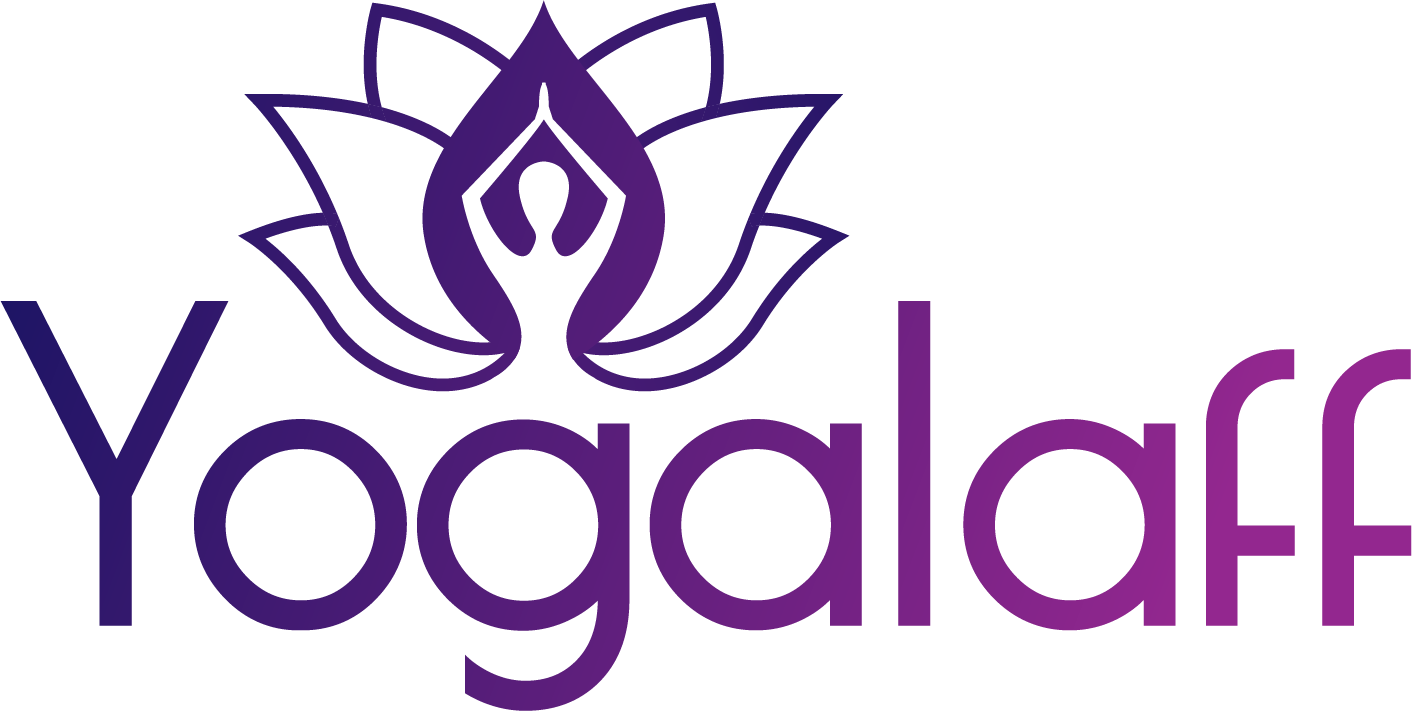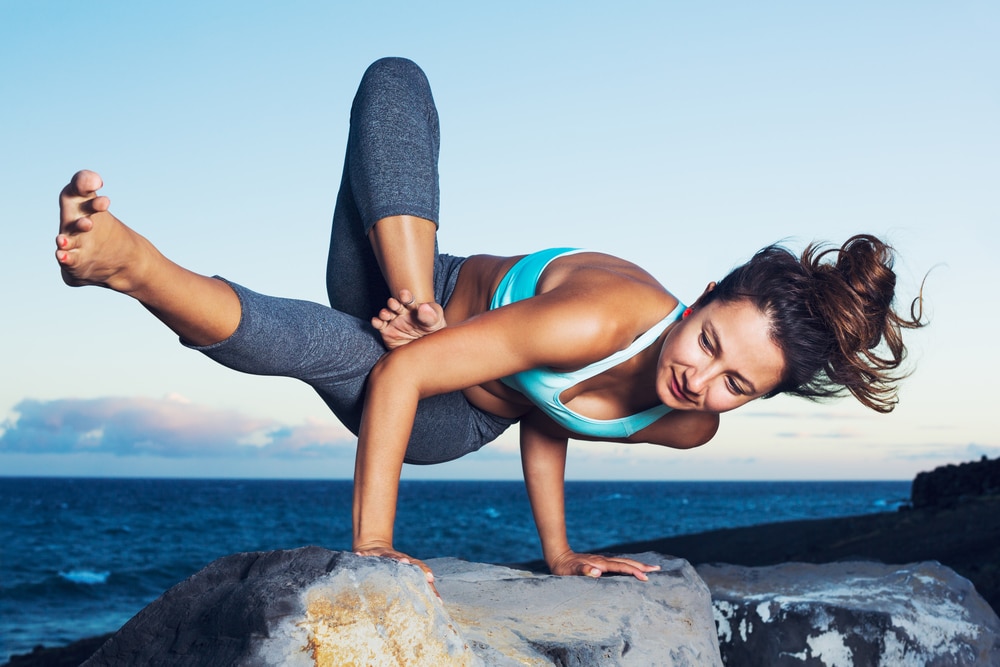
What is Yoga?
While we don’t know the exact time period that yoga was created in India, we know that it is a tradition and practice that has been around for thousands of years, only introduced into Western culture by the 20th century.
Translated from the Hindi language, Sanskrit, the word ‘yoga’ means ‘union’. This represents the union of the body, mind, and spirit, or the poses, breath, and philosophy. Separated, these practices are not ‘yoga’.
It is mandatory that the yoga practitioner includes all of these aspects into their life to be considered a student of yoga. Through the process, the yogi hopes to eventually reach the ultimate goal of yoga, which is enlightenment.
There are many interpretations of yoga that have been developed over the years that consist of different practices and philosophies, which will be explained soon, but they all aim to reach the same goal.
With that being said, there are many other benefits aside from enlightenment that a yogi experiences from a regular yoga practice, and we’ll be covering this next.
Why Should You Practice Yoga?
Yoga is a practice that was created to be inclusive for everyone, not just those of Hindi faith, or even Indian descent.
Indian teachers openly shared yoga with Western culture during the 20th century with the intention of teaching all people interested in the practice of yoga. A fascinating aspect of yoga is that it is not just a spiritual philosophy, and it is not just a physical or mental exercise.
Yoga, as we discussed earlier, is a practice and lifestyle that benefits the body, mind, and spirit. This makes it very unique, and therefore, it’s one of the reasons that yoga has become so popular today. Here, I will list some of the specific health benefits of yoga that you can expect from a consistent yoga practice:
7 Benefits of Practicing Yoga Regularly
1. Improved Breathing and Heart Health
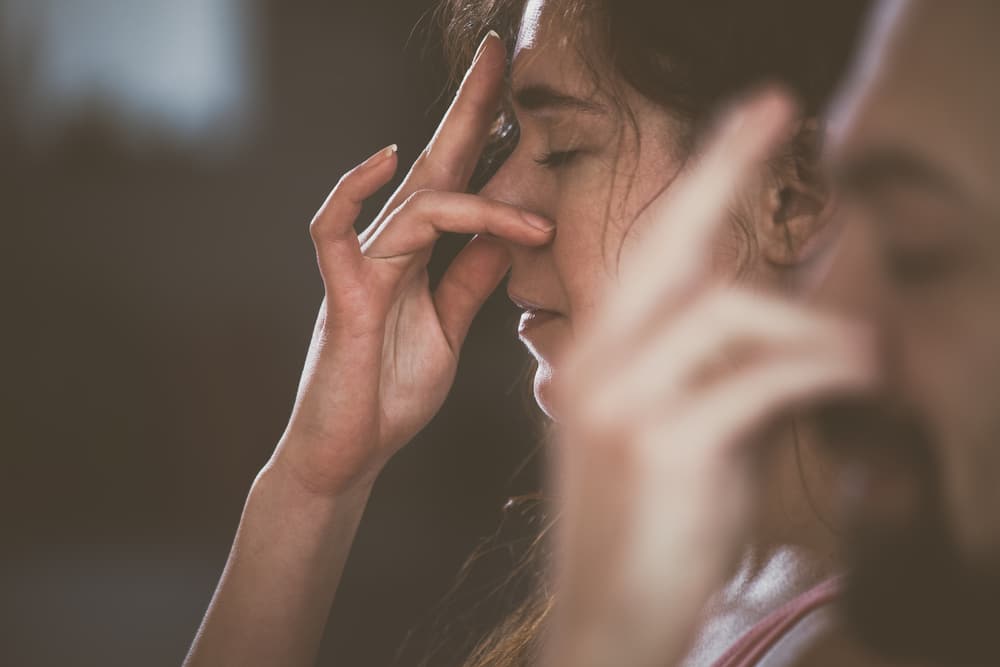 While there are many styles of yoga, practicing breathing techniques, or pranayama, is a common aspect. When you breathe mindfully, you send more oxygen to your lungs, and oxygenated blood to your heart, in turn bettering the health of your overall body.
While there are many styles of yoga, practicing breathing techniques, or pranayama, is a common aspect. When you breathe mindfully, you send more oxygen to your lungs, and oxygenated blood to your heart, in turn bettering the health of your overall body.
Also, by improving your breathing, you can deal with stress and anxiety in a calmer, more logical manner.
2. Increased Flexibility
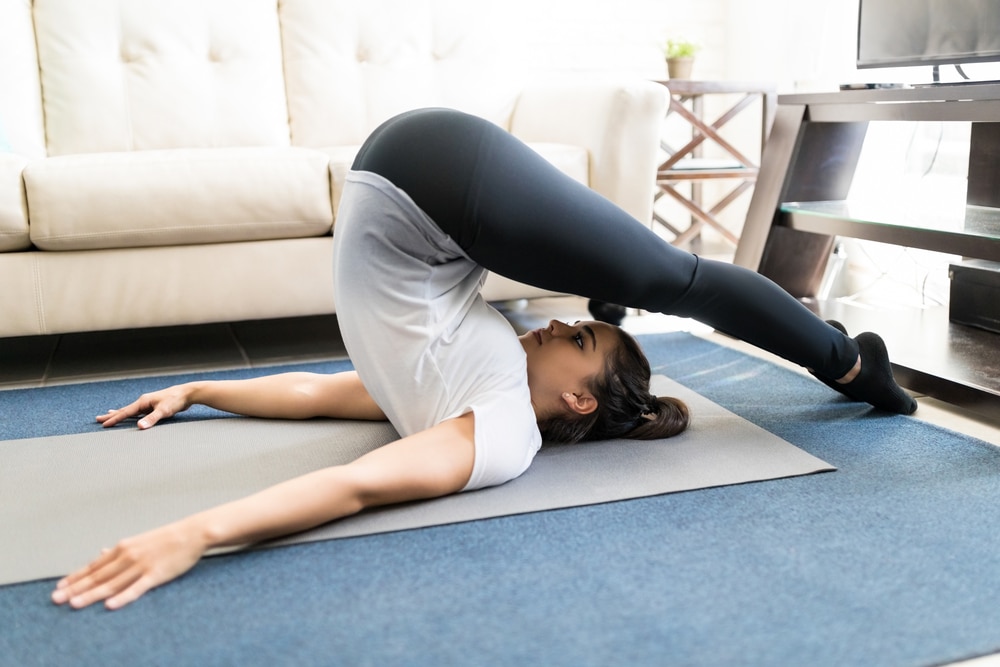 With certain yoga practices, such as vinyasa, yin, and hatha yoga, you put your body in poses that increase the flexibility of your muscles and tendons.
With certain yoga practices, such as vinyasa, yin, and hatha yoga, you put your body in poses that increase the flexibility of your muscles and tendons.
The focus on flexibility is especially important starting in your mid-20s as stress causes stiffness of the muscles, and our bodies are starting to need more stretching to maintain our range of motion.
3. Tones Muscles
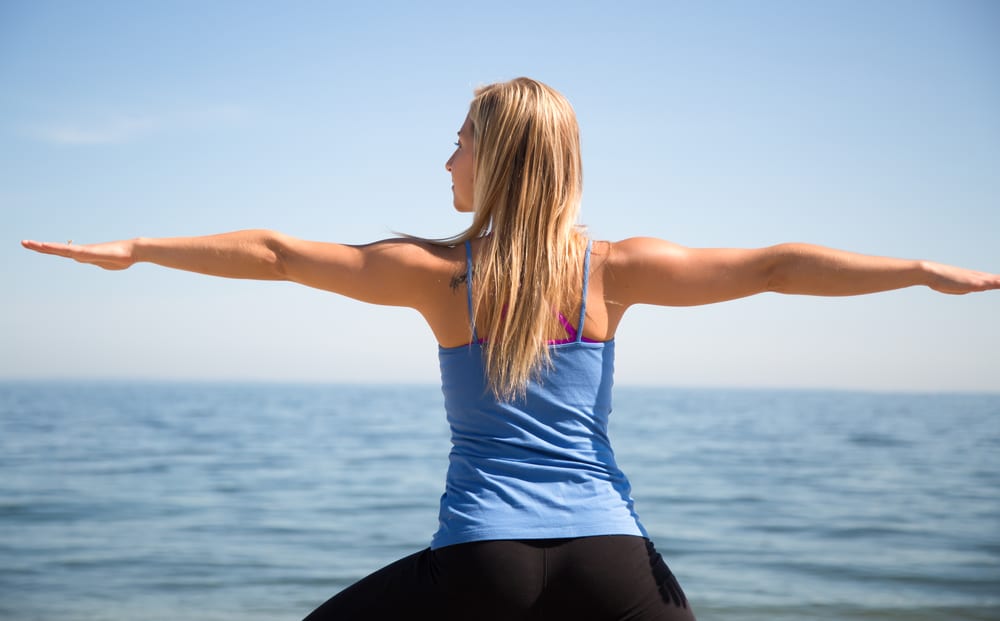 More challenging yoga practices such as vinyasa, Ashtanga, and Bikram yoga are known to tone your muscles due to the challenging poses and effort put into them.
More challenging yoga practices such as vinyasa, Ashtanga, and Bikram yoga are known to tone your muscles due to the challenging poses and effort put into them.
Not only does toning your muscles make you stronger, but it also protects your bones, which is essential since bone density lessens after the age of 30.
4. Healthy Weight Loss or Maintenance
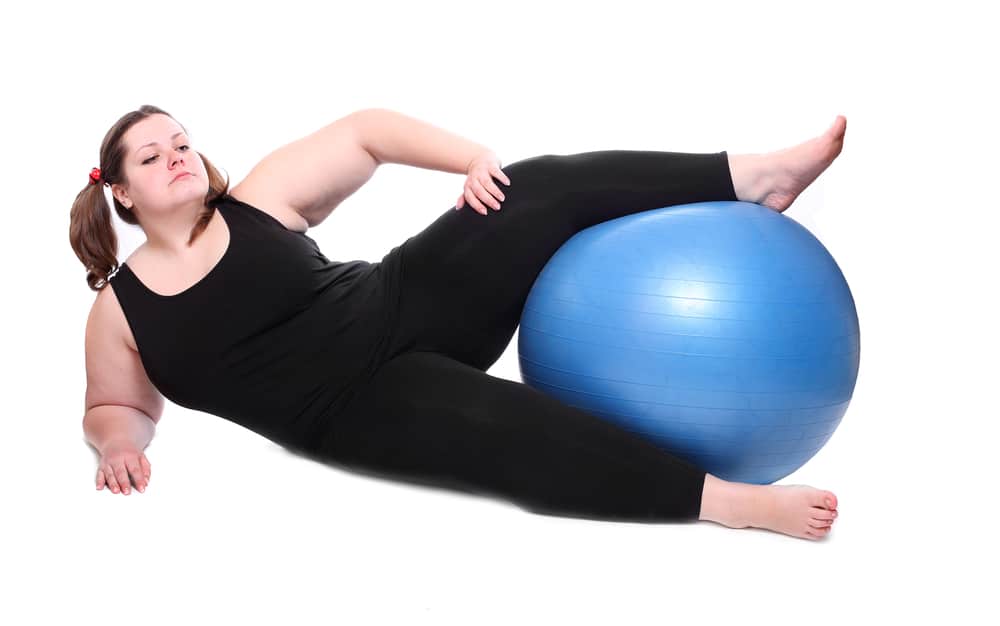 The challenging classes I mentioned in #3 are also used for weight loss, slimming your hips and thighs, getting rid of cellulite, or maintenance, depending on how much effort you put into the practice. This is important for preventing weight-related illnesses and boosting your confidence.
The challenging classes I mentioned in #3 are also used for weight loss, slimming your hips and thighs, getting rid of cellulite, or maintenance, depending on how much effort you put into the practice. This is important for preventing weight-related illnesses and boosting your confidence.
5. Decreased Stress and Anxiety
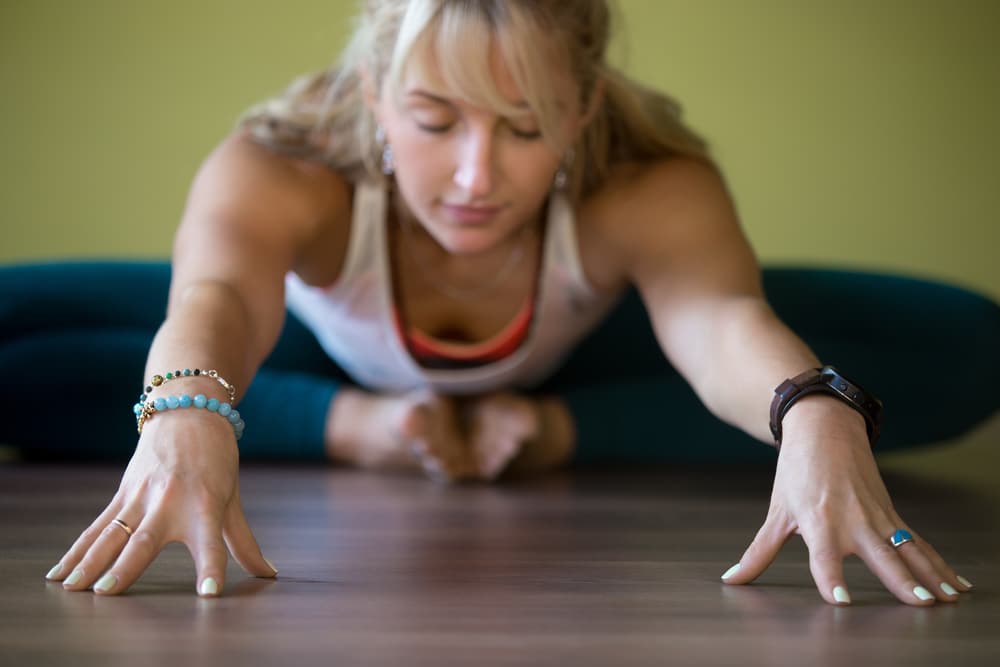 Yoga styles such as yin yoga, restorative yoga, and viniyoga are slower paced and breath focused, therefore helping the mind and body slow down. This decreases the symptoms of anxiety and decreases stress by teaching you to stay present in the moment and think clearly.
Yoga styles such as yin yoga, restorative yoga, and viniyoga are slower paced and breath focused, therefore helping the mind and body slow down. This decreases the symptoms of anxiety and decreases stress by teaching you to stay present in the moment and think clearly.
6. Heightened Self-Esteem and Confidence
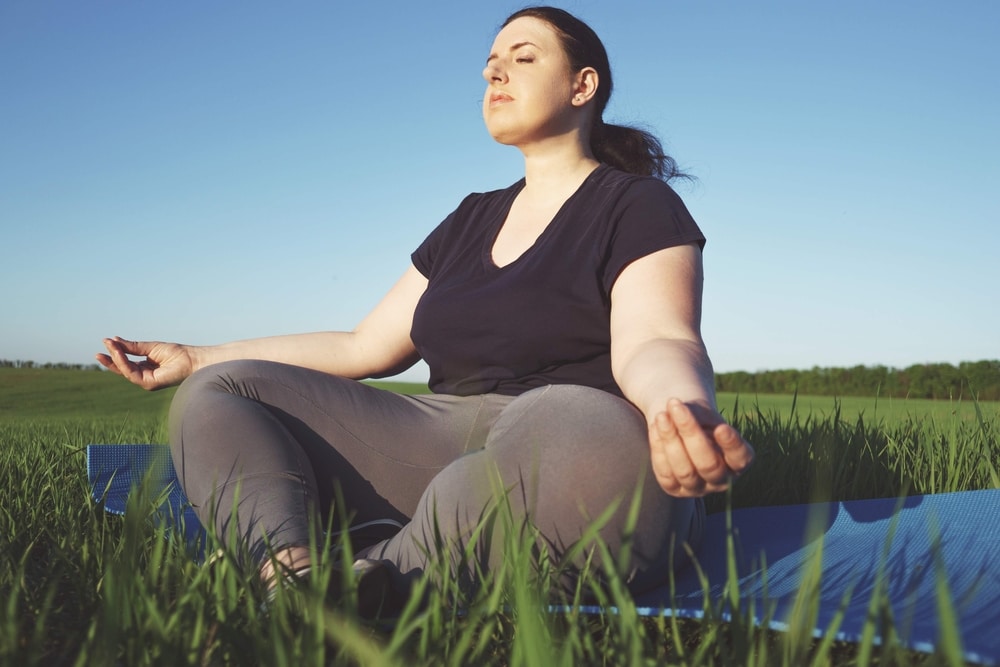 Whether you’re meditating or mastering a complicated pose, you will experience heightened self-esteem and confidence from your yoga practice. Yoga focuses on the journey, and not the end goal, so you can learn to have pride and gratitude wherever you are in the physical world.
Whether you’re meditating or mastering a complicated pose, you will experience heightened self-esteem and confidence from your yoga practice. Yoga focuses on the journey, and not the end goal, so you can learn to have pride and gratitude wherever you are in the physical world.
7. Betters Ability to Cope with Obstacles
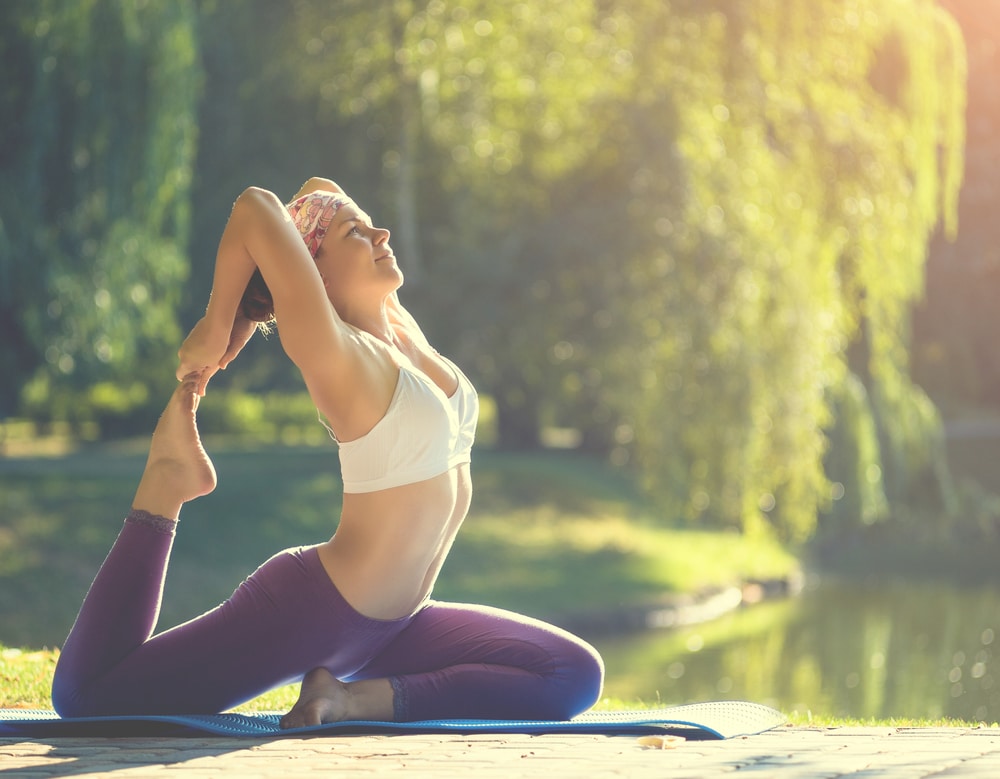 A yoga practice that involves active poses, or asana, like a workout, releases endorphins, working as a healthy tool to cope with hard times. Meditation also gives you the ability to mentally and physically process what you’re going through.
A yoga practice that involves active poses, or asana, like a workout, releases endorphins, working as a healthy tool to cope with hard times. Meditation also gives you the ability to mentally and physically process what you’re going through.
Neither is a quick fix, but they are healthy alternatives to using alcohol, cigarettes, drugs, and other vices. Also, by practicing yoga, you are dealing with problems independently, rather than having to depend on substances.
The Basics and Foundation
As briefly mentioned earlier, there are many common styles of yoga, that differ based on the practices and focus. Here, I will list some of those most popular yoga styles seen in Western culture.
7 Types of Yoga Practices
1. Ashtanga Yoga
Ashtanga Yoga is an advanced physical practice, highly structured, and vinyasa-style, meaning one pose flows to the next.
There are five Ashtanga asana series and students must master each pose of the first series before continuing to the second series, and so on. This is not a practice for beginners, but experienced yogis with a love for a physical challenge, and self-discipline.
2. Vinyasa Yoga
Similar to Ashtanga yoga, in Vinyasa yoga, poses flow from one to another and the speed of the class is often fast in comparison to other yoga classes. However, Vinyasa differs from Ashtanga in the sense that sequences can be different in each class.
There isn’t a set series like there is in Ashtanga. However, Vinyasa classes are often labeled in studios as level 1, level 2, and level 3, so you can gradually learn more challenging poses and receive less verbal direction with experience.
3. Hatha Yoga
If you’re new to yoga, a Hatha yoga class is a useful start if you’re looking to transition to Vinyasa or Ashtanga, as well as if you simply want a slower-paced, pose practice.
In this style of yoga, it’s easier to get a grasp of the basic poses and breathing techniques, due to the class being slower than a Vinyasa or Ashtanga class.
4. Bikram Yoga
Bikram, a type of hatha yoga, differs greatly from Vinyasa and Ashtanga. It is practiced in a heated room, which is often between 95 and 108 degrees fahrenheit, and there are 26 poses practiced each class, taught in a fixed sequence.
The teacher is given a specific script to explain the postures, and strictly does not practice with the students. This is to help the students to stay mindful and more focused during the class. The poses taught vary in difficulty, so beginners are encouraged to practice often until they feel comfortable with each pose.
5. Kundalini Yoga
This spiritual yoga style is meant to activate kundalini energy that will align the chakras or energy centers along the spine. The practice includes repetitive movements called ‘kriyas’, as well as unique breathing techniques, and chanting.
Another interesting characteristic of Kundalini yoga is that both students and teachers are advised to wear all white, which symbolizes purity. This is a good choice for yogis looking for a highly spiritual practice.
6. Yin Yoga
Yin yoga is a movement practice where you hold the poses for 3-5 minutes at a time. You can view this type of yoga as a movement meditation, relaxing the mind-body connection and increasing the flexibility of your more profound muscles, tendons, and ligaments. Breaths are done through the nose and should be inhaled and exhaled very slowly to further relaxation.
7. Restorative Yoga
If you have any injuries, limited mobility, or feel stressed, this practice is for you. Restorative yoga is a very comforting practice, as the poses are very soft and many props are used to support the body, such as yoga socks, straps, balls, wheels, blocks, and bolsters.
You can view this practice as the equivalent of getting a relaxing massage. It is very healing mentally and physically.
Popular Basic Yoga Poses
Now that you’re familiar with some of the more well-known yoga practices, let’s discuss some of the best poses to start learning as a beginner.
1. Mountain Pose: Tadasana
The Mountain Pose (Tadasana) is the standing pose, which all of the standing poses are rooted in. This pose can be used as a starting point, relaxation pose or as a stepping stone to improve upon overall posture.
I know what you are thinking – how can a simple standing pose do anything good for you? It is more than just standing on your two feet. Follow the steps below for getting into and out of this pose.
This is your standard standing position. Stand with legs hip-width apart, arms by your side with palms facing forward, and fingers spread wide. Straighten your spine, lower your shoulders and roll them back, and then tuck your pelvis in. Take a couple good breaths here.
This pose is packed with amazing benefits including improving posture, strengthening of your thighs, knees, and ankles, tightening of your core and buttocks along with relieving sciatica and flat feet.
It is more than just standing on your two feet. While this pose may look easy, it is not always that way for some yogis and they may need props or modifications which is completely fine.
Using the wall to stand against with your back, legs, back of feels, sacrum and shoulder blades is a great modification and prop for beginners or if you are feeling a bit unsteady.
Stand against the wall or away from the wall for three to five breaths. Other modifications also include adjusting the position of your arms, hands, and fingers.
Minor adjustments will do wonders and will change the way you look at this pose and will open the door for different ways to do this pose when you need modifications.
But If you are on the other side of the line and you want to challenge yourself in this pose there are minor adjustments that you can also make to accomplish this.
If you close your eyes and use muscle memory and the sense of touch to balance on your feet you will challenge yourself to dig deeper.
Although this pose is a simple standing pose there are certain precautions to take before doing this pose. If you are currently suffering from a headache, low blood pressure or insomnia, this pose is not recommended to add to your yoga practice.
Not to worry, there are other yoga poses that you can do if you suffer from those ailments.
2. Tree Pose: Vrksasana
Tree Pose (Vrksasana) is the standing pose that you can move into from Mountain Pose and if you want a challenge still, this is the pose for you. This pose is jammed packed with amazing benefits and if done consistently can improve many areas of your body. Below you will find a step-by-step guide to nailing this pose.
This is the beginner level balancing pose. From mountain pose, start to put pressure into your left foot, and bring your hands to your heart in a prayer position. Next, bring the sole of your right foot to your inner left ankle, with your right knee facing outward to the right.
If you can hold your balance here, bring the sole of the right foot to your inner left calf. If you can balance here, start to raise your arms up, like branches of a tree. Take some breaths here before coming out of the pose.
This challenging standing pose is not recommended for anyone suffering from headaches, insomnia, low blood pressure or high blood pressure (can be done without raising your arms above your head).
But on the flip side, there are benefits that come with doing Tree Pose if you are able to do it. Tree Pose strengthens your thighs, calves, ankles, and spine, stretches your groin, inner thighs, chest, and shoulders.
An improvement of balance and relief of sciatica and reduction of flat feet also occur when this pose is done consistently. If you have ever wanted to balance on one leg with your eyes closed, Tree Pose is your answer to dig deeper and challenge yourself.
The closing of the eyes is not recommended for beginners of this pose because you will quickly become discouraged, it is best to work your way to this variation.
But if you feel as though you need a less challenging version of the pose, you can always modify by standing with your back against a wall while balancing on one leg with the other leg bent and the sole of your foot either on your ankle or above your knee and your arms stretched overhead.
3. Downward Dog: Adho Mukha Śvānāsana
Downward Dog (Adho Mukha Svanasana) is by far the most popular yoga pose and believe it or not, this is one of the most relaxing and rejuvenating poses.
One would not believe it because you are in a tent shape looking at your feet but you would be surprised just how calming that can be if you just let it happen. If you allow the calm to come over your body, you will experience rejuvenation that can only be explained through pure experience.
Some yogis will go into this pose to rest and take breaths instead of child’s pose because it can, at times, be more relaxing. Although this is an extremely popular pose, it is not for everyone to do, for particular health reasons.
Pregnant yogis should not do this pose during the last trimester, there are prenatal yoga practices that are good for pregnant women but this pose is definitely not recommended. If you suffer from carpal tunnel or diarrhea is not the best pose for you.
If you suffer from high blood pressure or headaches, you can still do this pose but it is recommended that you provide support for your head in the form of a bolster or yoga block and always be sure to keep your ears between your arms, at even proportion.
If you want to get the most out of this pose but you are not in a position to go deep, you are more than welcome to modify this pose as much or as little as you need. Use a strap around your arms directly above your elbows and imagine the strap is firmly moving inward and with this, you press your shoulder blades outward.
But if you do want to go all in and have a deeper experience, you will stretch the back of your legs and lift very slowly onto the balls of your feet making sure that your heels are at least a half of an inch from the ground.
Your inner groins should be drawn into your pelvis and you should feel an active lift from the inner portion of your heels. Move the heels back to the ground and be sure to move the outer portion of your heels quicker than the inner portion.
Downward Dog Pose is most widely recognized pose in the world of yoga and for some yogis may be the most relaxing, even more so than child’s pose. But this pose is not recommended for anyone has health-related issues or who are temporarily out of commission from doing certain activities.
Downward Dog Pose has many incredible benefits for those that are able to experience this pose.
The pose increases energy in the body, stretches the shoulders, hamstrings, calves, arches, and hands, aides in preventing osteoporosis, increases digestion, relieves insomnia, headaches, fatigue and back pain.
If you suffer from high blood pressure, asthma, flat feet of sciatica, this pose will become your very best friend. Below you will find steps on how to do this pose.
Come into a plank position, and then push your hips and heels back, with pressure on the lower part of your hands’ palms. Continue to press into the heels until you get a stretch in your calves.
Let the head relax with your gaze looking forward. Take a couple breaths here before coming out of the pose.
4. Cobra Pose: Bhujangasana
Cobra Pose (Bhujangasana) is the ultimate heart opener pose and is good for anyone who is working on opening their heart to new experiences.
There is an open for mini cobra as well as full cobra and the choice is yours. Mini Cobra does not require a full and extensive heart opening position but full cobra does.
Depending on how you are feeling, you may want to do one or the other, or even both variations of this pose. This is actually a great beginner posse because you can modify very easily then work your way into the advanced versions of the pose and it is great to work yourself up to.
As with other poses, this pose is not recommended for individuals with certain health issues, ailments or conditions that force them to be out of commission for quite some time.
If you are currently suffering from any type of back injury, carpal tunnel, headaches or are pregnant, this pose is definitely not recommended for you to do.
Of course, consult your doctor before doing any type of pose if you have health issues or are pregnant but please be mindful of yourself and be gentle with yourself.
A great deal of flexibility is required to perfect Cobra Pose. Flexibility in the armpits, chest, and groin is recommended if you want to get into the full backbend and over time the flexibility will occur.
Consistent practice is necessary if you are wanting to make this pose your number one go to.
To help with perfecting this pose you can do modifications such as using a metal chair and holding onto the legs with your hands and lifting your arms, chest, and groin from the ground but always remembering to use the chair to support your stability.
Once you have grasped the concept of this pose, you will be able to appreciate the benefits this pose has for your body.
Such as increasing strength of your spine, stretching of the chest and lungs, shoulder and core, tightens the buttocks, provides relief of stress and fatigue, along with opening the heart and lungs and soothing of sciatica.
If you suffer from asthma, this pose is extremely beneficial for you and can provide relief for such. Below you will find steps on how to do this therapeutic pose.
As a beginner, the best way to come into this pose is by starting off on your belly. Bring legs together. Next, place your hands, palms downward, on each side of your chest, with your elbows bending.
Zip the shoulders in towards the chest, and then roll your shoulders back to open to the chest. You should have a slight backbend here. Take a couple breaths, and then relax the torso. You can do a couple repetitions to warm up the lower back.
5. Child’s Pose: Bālāsana
Child’s Pose (Balasana) is a resting pose used in many asana yoga practices and can be used and taken at any point during the practice or even for the whole practice.
The pose of stillness allows you to take a break and just breathe. This pose is popular during most of the challenging asana poses and you shall not feel ashamed for taking this pose.
You can use a blanket or other softcover props if your knees normally give you issues because this pose can cause a great deal of pain your knees if not rectified.
But if you are coming to this pose for anything else, you will receive just that.
This pose is packed with amazing benefits and can be experienced by anyone who wants to receive stretch in the hips, thighs, and ankles, along with the relief of back and neck and if you suffer from constant fatigue and depression, this pose is highly recommended for you to do.
A consistent practice of yoga will change your outlook on life which in turn will change your health and wellness.
As with many other poses, you can do different variations based on how deep or not deep you want to take the pose. Below you will find steps on how to do this amazing pose at home during a practice or at a studio.
You can also use this pose outside of yoga, please feel free to use this post at any time of your day if you ever feel as though you need to slow down.
Child’s pose is practiced in many yoga styles and has many benefits and different uses. When you do a relaxing child’s pose, it is useful after an active pose to rest the body.
When you do an active child’s pose, it lengthens the spine and stretches the neck, arm and shoulder muscles. I will describe both methods of child’s pose.
For relaxing child’s pose, start off in a kneeling position. Turn your knees outward slightly, so that there’s space between then to put your torso in. Next, bring your arms out in front of you, and continue to slide them forward, so that you can lower your torso and head forward.
Rest your head on the mat. Hands can be relaxed, and there can be space between your bum and ankles. Take a couple breaths here.
For the active child’s pose, come into a relaxing child’s pose first. Next, try to push your bum towards your ankles every couple of breaths, so that you lengthen the spine.
Try to bring your hands forward more to create space between your shoulder and arm, as well as activating the arm muscles. Also, focus on spreading the fingers wide, and pressing the hands into the mat. This makes for a more challenging child’s pose.
6. Corpse Pose: Savasana
Corpse Pose (Savasana) or better known as the final resting pose. This is normally done at the end of every asana practice. Used to calm the body after an asana yoga practice.
This pose calms your nerves and every other system in your body. Although this pose is the final resting pose, it also the most challenging because with rest comes little to no activity and that is extremely difficult for some yogis.
Still, even being the most relaxing pose, this pose is not recommended for pregnant women unless your head is propped up or for anyone who suffers from back injuries without propping your legs up on props to give your back a rest.
Helping to lower blood pressure, reduce headaches, fatigue and insomnia, along with a deep calm felt all over the body which in turn puts your brain in rest mode and instantly reduces stress, this pose is great to do, not only at the end of practice but also after a long day or at the beginning of each day.
Below you will find steps on how to do this final resting pose, it may look easy but this truly is one of the most challenging poses due to the act of doing nothing. While performing this pose can be somewhat frustrating because you will have to quiet your brain, it is more than worth it. Once you figure out how to master this pose in your own way, you will never want to relax any other way again.
Savasana, which translates to corpse pose, but is often called by its Sanskrit name, is the last pose of a Savasana practice. You’ll come onto your back, legs wide, arms by your side, and the whole body relaxed.
Close your eyes, and stay in savasana for at least five minutes to give your body and mind a break, and a time to process the yoga practice you’ve just completed. You can finish your entire practice after savasana, or follow it up with an ending meditation.
Popular Basic Breath Techniques
Let’s talk about some breathing techniques you can do before, during, or after a yoga practice. Depending on the breathing technique, you may become more stimulated or more relaxed. Think of the breath as a tool to improve and complement your pose practice.
Three-Part Breath
This breath technique can be implemented at the beginning of practice or the end of practice to relax your body. This will also help beginners build muscle strength to take deep breaths without feeling any pain or resistance.
In a seated position, start by taking deep nasal inhalations, sending the breath to your belly. Let the lower belly expand on the inhalation, and deflate on the exhalation. Do this at least five times. Next, during the nasal inhalation, send the breath to the area between your breasts and above your belly button.
Expand the muscles to let this part of your body rise. Deflate on the exhale. Again, do this at least five times. Lastly, during the nasal inhalation, send the breath to your chest, right below your collar bones. With enough air, this area will rise. Let it deflate on the exhale. You know the drill…at least five breaths here. Recognize how you feel now.
Ocean Breathing
Ocean breathing, or ujjayi pranayama, is useful during an active yoga practice, such as Ashtanga or Vinyasa. This is the type of breathing you’ll be doing while hold and moving through poses. This will aid in increased flexibility, as well as decrease pain when holding and deepening poses.
To do this, take a deep breath through the nostrils with your mouth closed. On the exhale, keep the mouth closed and let the warm air go down the throat, which will create an “ocean sound” (hence the name).
It may take some practice to get this down, but another way to think about it is that you’re using the same muscles as you would to fog a mirror or a car window on a cold day, but in this case, you keep your mouth closed.
Breath of Fire
This last breath technique is practiced in kundalini yoga and is very energizing. Start with a couple easy breaths before doing this breathing technique as a warm-up for the intercostal muscles surrounding the rib cage.
To do this breath, start off in a seated position, straighten the spine, and bring your arms out, bending the elbows like “cactus arms”. Next, curl the fingers of your hands in with your thumb facing up. Bring the shoulder and arms back a bit to open the chest.
After that, take a deep inhale through the nose and keep the mouth closed. On a quick exhale, expand the belly, and then on the inhale deflate the belly. This pattern should be done very quickly and continued for at least 30 seconds, and up to a couple minutes.
In the end, you should feel energized and ready for a fast-paced kriya. This is also a healthy substitute for coffee in the morning! Note: Do not do breath of fire if you’re a woman on your moon cycle (i.e., menstrual cycle).
The Beginner Stages of Yoga
Where to Start Your Practice
While the internet is making it easier to access yoga through videos and articles, I highly recommend starting with yoga classes in-person, so your teacher can adjust your alignment. Many beginners don’t realize that there are many alignment cues to do a yoga pose or transition safely.
Therefore, if a yoga teacher in a video skips an alignment cue, assuming her students know it, or if you simply don’t hear it, there’s no one to correct you.
The following are some places you can find yoga classes:
- Attending yoga studios
- Yoga classes at gyms and athletic clubs
- Yoga classes in physical therapy and chiropractic offices
- Corporate yoga offering at your workplace
- Hiring a private yoga instructor at your house, yoga studio, or a park
- Going to donation-based outdoor yoga events
Choose whichever options works best with your schedule and budget, and then stick to it at least 2 to 3 times per week! Once you have a home practice, you can attend classes less, if needed.
How to Approach the First Class
The first class is always scary because you don’t know what to expect and beginners tend to give themselves high expectations when in reality, a good yoga studio or class environment will not judge you.
If you are judged and class is taught like a boot camp, leave and find a new place to practice.
Once you do find a yoga class that has good vibes, be sure to bring your yoga mat, water, and if it’s an active class, a yoga towel, if you sweat a lot. Most places provide cheap yoga mats if you don’t have one yet or you can use a yoga mat alternative. Props such as blocks and straps are also provided, so you really don’t need much going into a yoga class.
Also, be sure to wear appropriate attire. If it is a Bikram class (i.e. hot yoga), they recommend wearing as little as possible due to the heat, however, in vinyasa and Ashtanga classes, shorts less than two inches below the butt are usually not allowed.
Aim for yoga leggings in those classes. If it is a restorative class or yin class with little movement, feel free to wear loose-fitting, comfortable clothing.
All classes are different, so mentality-wise, go in with an open mind. Some aspects of yoga may seem silly to beginners, but over time you learn the benefits of chanting Aum, Lion’s Breath, happy baby pose, and other seemingly silly things, so they start to feel more normal.
Also, don’t go in with negative self-talk. No one expects you to master poses during the first class or even the first few months of class. Have fun, learn, and don’t take your first class so seriously.
How to Continue Improving
Once you’ve taken a couple in-person classes, you can start incorporating a home practice into your routine. You’ll probably still draw a blank at this stage trying to come up with a home practice, so watch some YouTube videos, or a yoga DVD to guide you through a class. With that being said, it is still important to attend in-person classes to experience the community benefits of practicing with others, as well as continuing to receive adjustments from the teacher.
Intermediate Stages of Yoga
Dedication and Passion for Yoga
When you are in the intermediate stages of yoga, you start to develop a passion and dedication. Where before, you may have just been testing out the waters, you are now excited to make yoga a main part of your life. You’re starting to practice more and enjoy talking about yoga with other yogis.
Subtleties of Pose Alignment and Breathing Techniques
In beginning yoga classes, teachers tend to focus on safe alignment instruction and teach basic breathing techniques, so the students aren’t overwhelmed. In intermediate classes, students are taught more complicated breathing techniques, and basic yoga poses are taught with more challenging variations.
Ability to Stay Present
Beginners often struggle to stay in the present moment during yoga and meditation. They may accidentally sacrifice their conscious breathing or pose alignment to think about what they need to do next, worry about how they look in a pose or make a grocery list in their mind. As you start to become an intermediate level student, you’re able to focus better, be kind to yourself, and stay present for the full yoga practice.
What’s Next?
To transition from intermediate level from advanced, you may want to focus on learning Sanskrit, meditate for an hour, try advanced yoga poses, or learn more about yoga philosophy. Advancement is now less about the practice on the mat and more about taking the lessons you’ve learned on the mat to everyday life activities.
Advanced Stages
Practicing on the Mat Daily
As an advanced yogi, you should aim to practice yoga on the mat daily. This doesn’t mean you need to do an hour-long active class every day. You can switch up your practice to fit what your body and mind needs that day. Also, at this point, you’re so familiar with yoga, you can create a sequence for yourself that you know will work for your body.
Practicing Yoga Philosophy
While you may be introduced to yoga philosophy as an intermediate level yogi, you are now studying it seriously, and incorporating it into your everyday life. This includes the Yamas and Niyamas of yoga, learning the teachings and history of spiritual teachers from the past and present, and adopting a vegetarian or vegan diet.
Seek a Teacher Training
Not every yoga student wants to become a teacher, but if you do want to become a teacher, you’re ready at this level. You have self-awareness of your body-mind connection, you have higher consciousness, you are an experienced yogi, and you strive to learn to explain yoga philosophy and poses, so you can share the knowledge with others.
Final Words
I hope you feel a great sense of depth in this guide. I truly believe that yoga is for everyone, even people with thyroid disorders, plantar fasciitis, or breastfeeding mothers can do yoga.
It is my honor to share this knowledge with you, so you can start your yoga journey. Please know that every person’s journey is different, and if you ever feel you’ve gotten off the path, rest assured that you are always welcome to come back to it.
Sometimes yogis are not ready to fully commit, and that’s okay. Yoga will still be here when you are ready to commit to the poses, the meditation, the breath, and the moral guidance of this amazing, spiritual practice.
